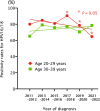Human papillomavirus vaccine impact on invasive cervical cancer in Japan: Preliminary results from cancer statistics and the MINT study
- PMID: 37688310
- PMCID: PMC10637081
- DOI: 10.1111/cas.15943
Human papillomavirus vaccine impact on invasive cervical cancer in Japan: Preliminary results from cancer statistics and the MINT study
Abstract
The first prophylactic vaccine against human papillomavirus (HPV) 16 and HPV18 was licensed in Japan in 2009. HPV vaccine effectiveness against high-grade cervical lesions has been demonstrated among young Japanese women, but evidence of its effects on invasive cervical cancer (ICC) is lacking. Using data from two different cancer registries, we compared recent trends of new ICC cases by age group using Poisson regression analysis. We also analyzed time trends in HPV16/18 prevalence among 1414 Japanese women aged <40 years newly diagnosed with ICC in the past decade. Based on the population-based cancer registry, the incidence of ICC among young women aged 20-29 years showed a significant decline from 3.6 to 2.8 per 100 000 women-years during 2016-2019, but no similar decline was observed for older age groups (p < 0.01). Similarly, using data from the gynecological cancer registry of the Japan Society of Obstetrics and Gynecology, the annual number of ICCs among women aged 20-29 years also decreased from 256 cases to 135 cases during 2011-2020 (p < 0.0001). Furthermore, a declining trend in HPV16/18 prevalence in ICC was observed only among women aged 20-29 years during 2017-2022 (90.5%-64.7%, p = 0.05; Cochran-Armitage trend test). This is the first report to suggest population-level effects of HPV vaccination on ICC in Japan. Although the declining trend in HPV16/18 prevalence among young women with ICC supports a causal linkage between vaccination and results from cancer registries, further studies are warranted to confirm that our findings are attributable to vaccination.
Keywords: cancer registry; cervical cancer; human papillomavirus; incidence; vaccination.
© 2023 The Authors. Cancer Science published by John Wiley & Sons Australia, Ltd on behalf of Japanese Cancer Association.
Conflict of interest statement
Takashi Iwata received research funds from MSD K.K. Junzo Hamanishi and Kazuhiro Takehara received lecture fees from MSD K.K. The other authors declare no conflict of interest.
Figures



References
-
- Falcaro M, Castañon A, Ndlela B, et al. The effects of the national HPV vaccination programme in England, UK, on cervical cancer and grade 3 cervical intraepithelial neoplasia incidence: a register‐based observational study. Lancet. 2021;398:2084‐2092. - PubMed

